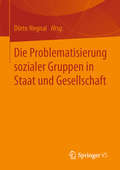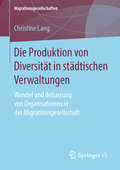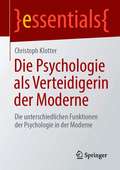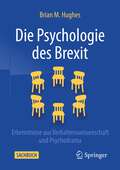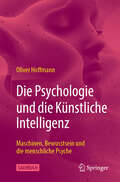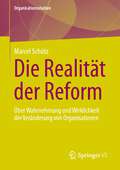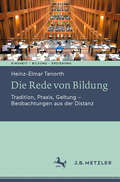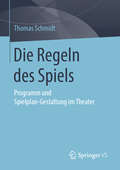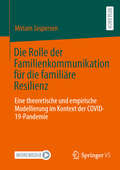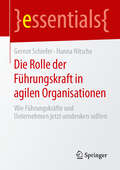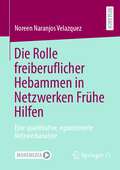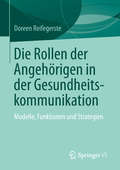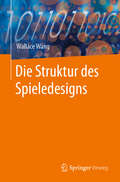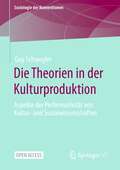- Table View
- List View
Die Problematisierung sozialer Gruppen in Staat und Gesellschaft
by Dörte NegnalGewalthafte Ereignisse schaffen Atmosphären von Bedrohung und Unsicherheit. Unter den Rufen nach politischen und justiziellen Lösungen wird die Sicherheitsfrage mit der Bestimmung und Bearbeitung vermeintlich spezifischer sozialer Gruppen beantwortet: die islamistischen Terroristen, die Ultras oder der Schwarze Block sind Versuche, soziale Phänomene zu personifizieren. Dabei ist wenig dazu bekannt, wie soziale Gruppen problematisiert und die so geschaffenen Zugehörigen hierin selbst aktiv werden. Der vorliegende Band versammelt aktuelle Forschungsbefunde zur Problematisierung sozialer Gruppen und offeriert das analytisch-konzeptionelle Potenzial für eine sozialwissenschaftliche Forschung.Der Inhalt· Theoretische Perspektiven zur Personifizierung sozialer Probleme· Doing Problem Group als (De)Stabilisierung von Kategorien im Zuge ihrer institutionellen Bearbeitung· Doing Problem Group in aktiven und passiven Wendungen problematisierender Zuschreibungen· Prozesse und Effekte von Problemgruppenkonstruktionen Die ZielgruppenWissenschaftlerinnen und Wissenschaftler, Dozierende und Studierende der Soziologie, Kriminologie, Politik-, Kultur- und Erziehungswissenschaften, der Sozialen Arbeit/ Sozialpädagogik und Philosophie Die HerausgeberinDr. Dörte Negnal ist Juniorprofessorin für Sozialwissenschaftliche Kriminologie am Department Erziehungswissenschaften | Psychologie der Universität Siegen.
Die Produktion von Diversität in städtischen Verwaltungen: Wandel und Beharrung von Organisationen in der Migrationsgesellschaft (Migrationsgesellschaften)
by Christine LangWie reagieren öffentliche Organisationen auf die migrationsbedingte Diversität? Das Buch untersucht städtische Verwaltungen und die Beschäftigung von Einwanderern und ihren Nachkommen. Anhand einer organisationssoziologisch basierten Studie zu Berliner Verwaltungen fokussiert es das Zusammenspiel verschiedener Praktiken, Strukturen und Kontexte, in dem Zugänge zur Beschäftigung hervorgebracht werden und sich unter Umständen verändern. Das Buch zeigt sowohl Triebkräfte organisationalen Wandels als auch Beharrungskräfte, die der Öffnung von Verwaltungen entgegenstehen und den Ausschluss von bestimmter ‚Diversität‘ zur Folge haben.
Die Prämedikationsambulanz: Analyse der Prozessqualität, Patientenzufriedenheit und Präoperativen Angst
by Sandro LorenzIn diesem Open-Access-Buch beschäftigt sich der Universitätsmediziner, Manager und Gesundheitswissenschaftler Sandro Lorenz mit der Zufriedenheit von Patientinnen und Patienten in der Prämedikationsambulanz einer großen deutschen Universitätsklinik. Ein zusätzlicher Fokus liegt auf der präoperativen Angst im Vorfeld einer Narkose bzw. Operation. Der Autor plädiert dafür, dass diese zunächst weichen Faktoren von anästhesiologischer Behandlungsqualität in einem Umfeld von Prozessoptimierung und zunehmendem ökonomischen Druck im Bereich der operativen Medizin und Anästhesiologie der stationären Leistungserbringer prototypisch für eine Erweiterung des hauptsächlich auf strukturellen und ergebnisorientierten Merkmalen beruhenden Qualitätsverständnisses stehen sollten. Die Analyse des Autors: Da wo das Arzt-Patienten-Verhältnis menschliche Wärme, Mitgefühl und Respekt vermissen lässt, fehlt nach meiner Einschätzung eine essentielle Komponente der Behandlung. Hingegen dort, wo fachliche Expertise und medizinische Kunst in einem professionellen Prozessumfeld ablaufen und wo Wirtschaftlichkeit und die gerechte Verteilung diese Bemühungen flankieren, dort ist die Wahrscheinlichkeit hoch, eine ausgezeichnete Versorgung zu finden, die nachhaltig angelegt ist.
Die Psychologie als Verteidigerin der Moderne: Die unterschiedlichen Funktionen der Psychologie in der Moderne (essentials)
by Christoph KlotterDie Menschen in Deutschland haben ein gleichgültiges bis schlechtes Verhältnis zu unserer Gesellschaft. Tatsächlich hat die Moderne, also die letzten 200 Jahre, der Bevölkerung einen historisch beispiellosen Fortschritt geschenkt: Demokratie, Menschenrechte, soziale Sicherungssysteme, nutritiver Überfluss. Doch gewürdigt wird dies wenig. Das mag daran liegen, dass wir uns im Sinne Diderots permanent bewähren müssen, wir also in einer Leistungsgesellschaft leben, die Leiden produziert. In der Moderne sind jedoch auch totalitäre Ideologien entstanden und umgesetzt worden, für die die Moderne auch verantwortlich ist. Dieses essential zeigt, dass die Psychologie sich bei näherem Hinsehen als Verteidigerin der guten Anteile der Moderne entpuppt.
Die Psychologie der Entscheidung: Eine Einführung
by Hans Rüdiger Pfister Helmut Jungermann Katrin FischerDieses Lehrbuch beschreibt, wie sich Menschen entscheiden, und erkl#65533;rt, warum Menschen manchmal zu Beurteilungen und Entscheidungen kommen, die aus der Perspektive rationaler Entscheidungen nicht optimal sind. Das allgemein verst#65533;ndlich geschriebene Werk richtet sich an Studierende, an Wissenschaftler und an alle Leser, die an den psychologischen Prozessen interessiert sind, die unsere Urteile und Entscheidungen beeinflussen. Leser lernen hier die wichtigsten psychologischen Theorien und Forschungsergebnisse der Entscheidungspsychologie kennen: Wie entstehen Pr#65533;ferenzen, wie gehen Menschen mit Zielkonflikten und mit Unsicherheit um, und welche Rolle spielen Emotion und Intuition beim Entscheiden. Auch erfahren Sie #65533;ber Entscheidungen in interessanten Anwendungsfeldern: Entscheidungen an der B#65533;rse, im Cockpit und im Gesundheitswesen. In dieser 4. Auflage wurden alle Kapitel komplett #65533;berarbeitet und auf den neuesten Stand gebracht. Zwei zus#65533;tzliche Kapitel erweitern das Themenspektrum, zum einen geht es um die Rolle von Emotionen bei Entscheidungen, zum anderen um die Integration von Entscheidungsprozessen in #65533;bergreifende kognitive Theorien. Die Entscheidungspsychologie ist Pr#65533;fungsstoff im Fach Allgemeine Psychologie, in der Sozialpsychologie und in der Arbeits- und Organisationspsychologie. Sie spielt eine wesentliche Rolle in den Wirtschaftswissenschaften (Behavioral Economics) und in anderen Sozialwissenschaften wie der Soziologie und den politischen Wissenschaften. In Bereichen wie der Medizin und dem Gesundheitswesen oder bei der Analyse technischer und gesellschaftlicher Risiken finden entscheidungspsychologische Faktoren zunehmend Beachtung.
Die Psychologie des Brexit: Erkenntnisse aus Verhaltenswissenschaft und Psychodrama
by Brian M. HughesIn diesem fesselnden Buch untersucht der Psychologe Brian Hughes, was die wissenschaftliche Psychologie über die Dynamik des Brexit enthüllt, was der Brexit uns über uns selbst lehrt und was wir tun können, um mit seinen kurzfristigen Auswirkungen und langfristigen Folgen umzugehen. Anders als die meisten kulturellen Umwälzungen ist der Brexit nicht das Ergebnis einer zufälligen Tragödie oder eines spontanen wirtschaftlichen Aufruhrs. Vielmehr existiert er, weil die Menschen beschlossen haben, ihn zu vollziehen. Er ist ein Produkt der menschlichen Psychologie - in entscheidender Weise geprägt von den Wahrnehmungen, Vorlieben, Ideen, Selbstbildern, Gruppenzugehörigkeiten und mehr oder minder begründeten Schlussfolgerungen der Menschen. Im Buch wird erörtert, wie Denkfehler und Kontrollillusionen die Sichtweisen sowohl der Leaver als auch der Remainer verzerren. Es zeigt wie ansonsten unbegründete Überzeugungen in der Alltagskultur gedeihen. Außerdem erforscht der Autor die psychologischen Auswirkungen des Brexit - auf soziale Einstellungen, Zukunftsdenken und die kollektive und individuelle psychische Gesundheit.
Die Psychologie und die Künstliche Intelligenz: Maschinen, Bewusstsein und die menschliche Psyche
by Oliver HoffmannIn einer Welt, in der Künstliche Intelligenz (KI) zunehmend in unseren Alltag integriert wird, stellt dieses Buch die entscheidenden psychologischen Fragen: Wie beeinflusst KI unser Denken, unsere Wahrnehmung und unsere Beziehungen? Was macht das Zusammenspiel von Mensch und Maschine mit unserer Psyche? Und können Maschinen jemals menschliche Emotionen, Kreativität oder Moral nachahmen – oder gar übertreffen? Das Buch beleuchtet die psychologischen Mechanismen, die durch die Mensch-Maschine-Interaktion ausgelöst werden, und geht der Frage nach, ob Maschinen ein eigenes Bewusstsein entwickeln können. Es untersucht die potenziellen Risiken und Chancen, die sich ergeben, wenn wir immer mehr Entscheidungen und emotionale Bindungen an KI-Systeme delegieren. Die Kapitel reichen von der Analyse von Maschinenbewusstsein und emotionaler Intelligenz bis hin zur Frage, wie KI unsere Autonomie beeinflusst und ob Maschinen moralische Entscheidungen treffen können. Durch die Verknüpfung von Psychologie, Philosophie und Technologie zeigt das Buch auf, dass KI nicht nur eine technische Revolution darstellt, sondern auch eine fundamentale Herausforderung für unser Selbstverständnis als Menschen. Es lädt die Leser ein, sich den existenziellen und psychologischen Konsequenzen der KI zu stellen und eine kritische Auseinandersetzung mit unserer zukünftigen Rolle in einer Welt zu führen, die zunehmend von intelligenten Maschinen bestimmt wird.
Die Radikale Rechte: Biopsychosoziale Wurzeln und internationale Variationen
by Klaus WahlDieses Buch analysiert den Anstieg von Fremdenfeindlichkeit, Rassismus und rechtsradikalen politischen Parteien, Bewegungen und gewalttätigen Gruppen in den letzten Jahren.Der Autor gibt einen Überblick über den aktuellen Stand der internationalen und interdisziplinären Forschung zu den vielschichtigen Erklärungen für rechtsradikales Gedankengut und vergleicht Ähnlichkeiten und Unterschiede in Europa und den Vereinigten Staaten. Durch die Integration von Erkenntnissen aus Psychologie, Geschichte, Sozial- und Lebenswissenschaften schlägt er ein biopsychosoziologisches Modell der Bedingungen, Ursachen, Katalysatoren und Auslöser von Phänomenen der radikalen Rechten in der ganzen Welt vor. Auf der Grundlage einer Analyse von "Nachfrage" und "Angebot" untersucht Wahl das Zusammenspiel von evolutionären emotionalen Mechanismen und Sozialisationsprozessen mit verschiedenen Umweltbedingungen und den daraus resultierenden Erscheinungsformen rechtsradikaler Gruppen, um Strategien zur Verlangsamung des Aufstiegs und der Auswirkungen der radikalen Rechten zu ermitteln.
Die Realität der Reform: Über Wahrnehmung und Wirklichkeit der Veränderung von Organisationen (Organisationsstudien)
by Marcel SchützVeränderungsprogramme zählen längst zum klassischen Projektrepertoire vieler Unternehmen, Banken, Verbände und Verwaltungen. Ihr Nutzen wird darin gesehen, betriebliche Komplexität auf ein handhabbares Maß zu reduzieren und organisatorische Zwecke im Hinblick auf umweltliche Erwartungen in neuartiger Weise zu begründen und auszurichten. Eine diesbezüglich rein zweckrational-instrumentelle Sicht vermag es jedoch nicht in Gänze, den tatsächlichen Erlebnis-, Entscheidungs- und Aktionshorizont entsprechender Veränderungsprojekte zu erfassen. Mit einer empirischen Forschung in einem größeren Finanzinstitut wird nachvollzogen, wie sich neben einer technisch-methodischen Seite des Projektmanagements ergänzend eine eigene ,Reformrealität‘ des Entscheidens ausbilden kann, deren Beitrag darin besteht, in der Organisation plausibilisierte Umwelterwartungen in anschlussfähiger Art und Weise zu konstruieren.
Die Realschule als Modell mittlerer Bildung: Geschichte, Bildungsgang, Kontroversen, Praxis
by Konrad FeesIn der vorliegenden Studie wird die Schulform Realschule in ihrer Besonderheit unter den Aspekten Historie, Bildungsgang, Schülerschaft, Lehrerbildung, Beschäftigungspolitik und Schulleistung untersucht und vorgestellt. Es wird gezeigt, dass die Realschule über Jahrzehnte erfolgreich eine solide Grundbildung mit einer anwendungsorientierten fachlichen und überfachlichen Bildung verband, die zum Eintritt in aussichtsreiche Laufbahnen in Technik, Handel, Dienstleistung und Verwaltung befähigte. Im Zuge der jüngeren Schulentwicklung mit veränderten Übergangsquoten und dem Aufkommen bildungsgangübergreifender Angebotsformen droht das bewährte Modell mittlerer Bildung allerdings obsolet zu werden. In dieser Situation ist eine Besinnung auf die Alleinstellungsmerkmale realer Bildung notwendig.
Die Rede von Bildung: Tradition, Praxis, Geltung - Beobachtungen aus der Distanz (Kindheit – Bildung – Erziehung. Philosophische Perspektiven)
by Heinz-Elmar TenorthBildung gehört zu den zentralen Begriffen der öffentlichen Debatte über die wünschenswerten Zukünfte von Individuen und Gesellschaft, über die Praxis des Bildungswesens und über Chancengleichheit und Bildungsgerechtigkeit. Gleichzeitig ist der Begriff mit Erwartungen überlastet und seine theoretische Qualität bestenfalls ungeklärt. Zur Prüfung von Status, Funktion und Geltung des Begriffs rekonstruiert der Band zunächst (I) die Tradition des Bildungsdenkens und die seither argumentativ verengte Praxis der Rede von Bildung. Gegen die Dominanz von Emphase, Skepsis und Kritik wird dann (II) demonstriert, dass und wie Bildung im Lebenslauf und im Bildungssystem möglich wird. Abschließend (III) wird kritisch geprüft, ob sich die Rede von Bildung auch als Bildungstheorie ausweisen kann. Redeform und Lebensform von Bildung haben, so das Fazit, zwar lebensweltliche, aber keine theoretische Geltung.
Die Regeln des Spiels: Programm und Spielplan-Gestaltung im Theater
by Thomas SchmidtDas Buch führt in die Grundlagen und Abläufe der Erstellung eines Theaterspielplans ein und beleuchtet dessen Bedeutung für die Programmierung und das Management von Theatern. Es füllt damit eine wichtige Lücke in der Theater- und Theatermanagement-Literatur. Schmidt untersucht die Spielplan-Gestaltung öffentlicher Theater auf der Grundlage von ausführlichen Spielplan-Analysen, zahlreichen Umfragen unter Dramaturgen und einer mehrjährigen Feldstudie. Aus den Ergebnissen entwickelt der Autor ein Modell der Spielplan-Gestaltung als zentrales künstlerisches und ökonomisches Managementinstrument des Theaters.Der Inhalt· Der Traum vom idealen Spielplan· Das deutsche öffentliche Theatersystem und das Stadttheater· Das Feld als kulturtheoretischer Rahmen des Theaters · Spielplan-Gestaltung in der Theaterpraxis – Eine empirische Untersuchung· Die Phasen der Spielplan-Gestaltung· Die Regeln des Spiels Die Zielgruppen · Studierende, Lehrende und Wissenschaftler in den Gebieten Kulturmanagement, Kultur- und Theaterwissenschaften, Dramaturgie, Regie, Schauspiel, Oper und Tanz· Mitarbeiterinnen und Mitarbeiter der Künstlerischen Leitungen und des Managements am Theater· Theaterinteressierte Menschen Der AutorThomas Schmidt ist Professor für Theatermanagement und Direktor des Studiengangs Theater und Orchestermanagement in Frankfurt am Main. Er war Gastprofessor an der Harvard-University, Gastdozent an verschiedenen anderen Universitäten und Geschäftsführender Direktor des Nationaltheaters Weimar.
Die Regelung der Gesundheitsversorgung Geflüchteter: Das Beispiel der Versorgung bei psychischen Erkrankungen
by Renate Reiter Thomas Gerlinger Annette Elisabeth Töller Constanze JandaDas Buch untersucht Regelungen, Formen, Reichweite und Triebkräfte der Bearbeitung der spezifischen psychiatrisch-psychotherapeutischen Versorgungsbedarfe von Geflüchteten in Deutschland. Dabei werden diverse regelungsbedürftige Problemfelder (z.B. Bedarfsermittlung, Sprachmittlung, Leistungsgewährung bzw. Leistungszugang mit oder ohne elektronische Gesundheitskarte, Rolle der Zivilgesellschaft etc.) auf der Bundes-, der Bundesländer- und der Kommunalebene sowie der Ebene der Zivilgesellschaft in den Blick genommen.
Die Resiliente Stadt: Konzepte, Konflikte, Lösungen
by Sigrun Kabisch Dieter Rink Ellen BanzhafResilienz ist das Konzept der Stunde. Die Coronakrise, die Flutkatastrophe im Ahrtal und die Energieknappheit haben Resilienz an die Spitze der politischen Agenda gesetzt. Auch für die Stadtentwicklung gilt Resilienz als Ziel. Doch was steckt hinter diesem relativ neuen Begriff? In diesem Open-Access Band erfahren die Leser*innen wie Städte auf Krisen und Katastrophen besser vorbereitet werden müssen, um diese gut zu überstehen und gestärkt aus ihnen hervorzugehen. Die Beiträge zeigen konkrete Beispiele, wie Städte resilienter gestaltet werden können.Welche Voraussetzungen müssen dafür geschaffen werden und welche Hindernisse gibt es? Für das Ziel urbaner Resilienz bedarf es rascher, tiefgreifender und systemischer Wandlungen auf allen Ebenen, von der Gesamtstadt bis zum Quartier oder der Nachbarschaft. Der Weg dahin und die entsprechenden Instrumente sind vielfach bekannt; dennoch wird bislang nicht mit der notwendigen Entschlossenheit vorgegangen. Dieser Band enthält empirisch belegte Beispiele aus der aktuellen Stadtforschung, zeigt Konflikte auf und diskutiert Lösungen. Die Beiträge analysieren, wie bestehende Einsichten zum Handeln führen und vorhandenes Wissen klug eingesetzt werden kann. Sie verweisen auch darauf, warum existierende Lösungsvorschläge nicht zum Einsatz kommen. Anhand der Betrachtung unterschiedlicher kommunaler Handlungsfelder wie blau-grüner Infrastrukturen, Energie- und Wärmewende, Umweltstressoren, Wohnen und Gesundheit wird ein tieferes Verständnis für die resiliente Stadt entwickelt. Das Werk richtet sich an Stadt- und Regionalplaner*innen, Geograph*innen, Stadtforscher*innen und Umweltwissenschaftler*innen sowie an Verantwortliche in Kommunalpolitik und -verwaltung.
Die Rolle der Familienkommunikation für die familiäre Resilienz: Eine theoretische und empirische Modellierung im Kontext der COVID-19-Pandemie
by Miriam JaspersenKrisen wie die COVID-19-Pandemie haben die Bedeutung familiärer Resilienz und Kommunikation in den Fokus gerückt. Insbesondere die Rolle der innerfamiliären Kommunikation wurde in der bisherigen Resilienzforschung jedoch noch nicht umfassend untersucht. Die Autorin entwickelt ein erweitertes Rahmenmodell familiärer Resilienz, das kommunikationswissenschaftliche, psychologische und soziologische Perspektiven integriert. Dabei werden kommunikative und sozialstrukturelle Schutz- sowie Risikofaktoren systematisiert. Mithilfe einer standardisierten Online-Befragung von Eltern wird analysiert, inwieweit sozialstrukturelle und kommunikative Faktoren im Kontext der COVID-19-Pandemie zur Anpassungsfähigkeit beigetragen haben. Die Ergebnisse zeigen, dass vor allem kommunikationsbezogene Faktoren entscheidend für funktionale und dysfunktionale Anpassungsprozesse sind. Die theoretischen und empirischen Erkenntnisse der Arbeit unterstreichen die Relevanz kommunikationsbezogener Resilienzfaktoren und liefern wichtige Impulse zur Stärkung familiärer Resilienz insbesondere in Zeiten globaler Unsicherheit.
Die Rolle der Führungskraft in agilen Organisationen: Wie Führungskräfte und Unternehmen jetzt umdenken sollten (essentials)
by Gernot Schiefer Hanna NitscheIn diesem essential werden Chancen und Hindernisse bei der Umsetzung agiler Personalführung fokussiert und Ansätze dargestellt, Führungskräfte bei dieser zentralen Aufgabe zu unterstützen. Die Autoren skizzieren die Herausforderungen einer Führungskraft, die ihren Mitarbeitern agile Denk- und Arbeitsweisen vorleben soll. Sie arbeiten heraus, wie die Unternehmensspitze und das Personalmanagement dazu beitragen können, dass Führungskräfte dieser Rolle gerecht werden. Nicht zuletzt wird auf die Abhängigkeit der Führungskultur von der Unternehmenskultur aus Sicht der Führungskräfte eingegangen.
Die Rolle der Mittelschichten im Arabischen Frühling: Ein Überblick (essentials)
by Rachid OuaissaDer Beitrag diskutiert die Rolle der Mittelschichten in den Transformationsprozessen der arabischen Welt in der jüngeren Geschichte. Rachid Ouaissa vertritt die These, dass die arabischen Mittelschichten zwar die Hauptträger von Protesten sind, jedoch keine strukturellen Druckmittel besitzen, um Demokratisierung durchzusetzen. Denn im Gegensatz zu den profitorientierten europäischen Mittelschichten sind die arabischen Mittelschichten klientelisiert und rentenorientiert.
Die Rolle des Führungskräfteverhaltens für das innerbetriebliche Konfliktmanagement: Eine empirische Analyse der Führungsbeziehungsqualität (BestMasters)
by Anna Lena WolffDiese empirische Studie beleuchtete den Zusammenhang zwischen Führungsbeziehungsqualität (Leader-Member Exchange) und dem Konfliktverhalten von Mitarbeitenden gegenüber ihren Vorgesetzten. Mittels einer Online-Befragung von 111 Personen wurden Daten zu ihren Erfahrungen mit Führungskräften und ihrem Konfliktverhalten (basierend auf Rahims Konfliktmodell) erhoben. Die Ergebnisse zeigen eine signifikant positive Korrelation zwischen hoher Führungsbeziehungsqualität und den kooperativen Konfliktverhaltensweisen Integration und Nachgeben. Das deutet darauf hin, dass Mitarbeitende bei einer starken Beziehung zur Führungskraft eher zur Kooperation neigen. Für Kompromiss, Vermeiden und Durchsetzen wurden keine signifikanten Zusammenhänge gefunden. Die Studie liefert somit Hinweise, dass die Förderung hochwertiger Führungsbeziehungen (z.B. durch Kommunikationsschulungen, Mentoring) kooperatives Konfliktmanagement im Unternehmen stärkt und somit zur Wettbewerbsfähigkeit beitragen kann. Einschränkungen in der Reliabilität und Validität wurden dabei reflektiert.
Die Rolle des sozialen Umfeldes bei der Studienentscheidung (Higher Education Research and Science Studies)
by Barbara FrankeBarbara Franke thematisiert in dem vorliegenden Buch die Rolle des sozialen Umfeldes der Studienberechtigten im Prozess der Studienentscheidung. Basierend auf soziologischen Wert-Erwartungs-Theorien und unter Berücksichtigung psychologischer, sozialkapitaltheoretischer und netzwerktheoretischer Ansätze werden die Mitschüler*innen, Freund*innen, Eltern und weitere relevante Netzwerkkontakte als Einflussfaktoren betrachtet und das Zusammenspiel zwischen kontextualen und individuellen Merkmalen ermittelt. Die empirischen Befunde belegen die Relevanz des sozialen Umfeldes bei der Studienentscheidung. Die Normen und das Verhalten relevanter Bezugsgruppen stehen direkt und indirekt im Zusammenhang mit der Entscheidung, ob Studienberechtigte ein Hochschulstudium aufnehmen.
Die Rolle freiberuflicher Hebammen in Netzwerken Frühe Hilfen: Eine quantitative, egozentrierte Netzwerkanalyse
by Noreen Naranjos VelazquezRegionale Vernetzung von Angeboten Früher Hilfen erhöht die Wahrscheinlichkeit für gesundes und sicheres Aufwachsen von Kleinkindern. Aus sozialökologischer Perspektive ist anzunehmen, dass Interaktionen im Netzwerk abhängig sind vom Kontext und persönlichen Merkmalen. Erstmalig genutzt wurde die egozentrierte Netzwerkanalyse, um interprofessionelle Vernetzung freiberuflicher Hebammen im Rahmen einer Lokalstudie standardisiert zu untersuchen. Daten von Hebammen und Adressatinnen wurden mit Mehrebenenanalysen und multiplen linearen Regressionen statistisch ausgewertet.
Die Rollen der Angehörigen in der Gesundheitskommunikation: Modelle, Funktionen und Strategien
by Doreen ReifegersteIn diesem Buch werden die zentralen Rollen der Angehörigen in der Gesundheitskommunikation aus Modellen der Kommunikationswissenschaft, Psychologie, Soziologie und den Gesundheitswissenschaften abgeleitet. Darauf basierend werden Strategien der Angehörigenkommunikation vorgestellt, die unabhängig von bestimmten Krankheiten und Kommunikationskanälen zum Einsatz kommen. Dies trägt zum Verständnis der potentiellen positiven sowie negativen Wirkungen von Angehörigen in Kommunikationsprozessen bei und dient als Grundlage für die Entwicklung entsprechender Interventionen in der Gesundheitsversorgung.
Die Sozialstruktur Deutschlands im internationalen Vergleich
by Christian SteuerwaldNationale Sozialstrukturanalysen machen im Zeitalter der Globalisierung immer weniger Sinn. Daher wird in diesem Buch die Entwicklung der deutschen Sozialstruktur mit der anderer Länder verglichen. Im Mittelpunkt stehen dabei europäische Länder, in vieler Hinsicht werden aber auch außereuropäische, moderne und sich entwickelnde Länder einbezogen. Im Einzelnen werden Strukturen der Bevölkerung, der Haushalte und Familien, der Bildung und der Erwerbstätigkeit, der sozialen Ungleichheit, der sozialen Sicherung und der Lebensweisen einander gegenüber gestellt. Vergleichsmaßstäbe werden aus Modernisierungstheorien gewonnen.
Die Struktur des Spieledesigns
by Wallace WangDie Struktur des Spieledesigns soll angehenden und erfahrenen Spieleentwicklern helfen, ihre Ideen in funktionierende Spiele umzusetzen. Die Erstellung eines Spiels erfordert das Verständnis der grundlegenden Elemente aller Arten von Spielen, angefangen von papierbasierten Spielen bis hin zu den neuesten Videospielen. Durch das Verständnis, wie diese grundlegenden Prinzipien in allen Arten von Spielen funktionieren, können Sie dieselben Prinzipien anwenden, um Ihr eigenes Spiel zu entwerfen.Spiele handeln von Zielen, Struktur, Spiel und Spaß. Während jeder seine eigene Vorstellung davon haben wird, was "Spaß" sein könnte, kann jeder Spieleentwickler die Freude der Spieler maximieren, indem er bedeutungsvolle Entscheidungen anbietet, die verschiedene Risiken und Belohnungen mit sich bringen. Solche Herausforderungen, kombiniert mit Regeln und Einschränkungen, zwingen die Spieler, Hindernisse und Probleme mit verschiedenen Fähigkeiten wie Geschicklichkeit, Rätsellösung,Intelligenz und Strategie zu überwinden. Im Wesentlichen ermöglichen Spiele den Spielern, in neuen Welten voranzukommen und Probleme in einer sicheren, aber aufregenden Umgebung zu überwinden, die es ihnen ermöglicht, am Ende zu triumphieren.Genau wie das Spielen von Spielen weltweit bei allen Altersgruppen, Geschlechtern und Kulturen beliebt ist, erfreut sich auch das Game Design gleichermaßen großer Beliebtheit. Spiele können die Spieler herausfordern, den besten Zug zu machen, Rätsel zu lösen, sich im Kampf zu engagieren, Ressourcen zu verwalten und Geschichten zu erzählen. Indem man versteht, wie Zufall, Psychologie und Balance die Art und Weise beeinflussen können, wie Spiele gespielt werden, können die Leser entscheiden, welche Spielelemente am besten für ihre eigene Spielkreation geeignet sind.Ob Ihr Ziel darin besteht, Geld zu verdienen, etwas Neues zu lernen, eine soziale Aussage zu machen, eine bestehende Spielidee zu verbessern oder Ihre künstlerischen, programmierenden oder gestalterischen Fähigkeiten zu testen, kann das Game Design genauso viel Spaß machen wie das Spielen von Spielen. Indem Sie die Teile eines Spiels kennen, wie sie funktionieren, wie sie interagieren und warum sie Spaß machen, können Sie Ihr Wissen nutzen, um jede Idee in ein Spiel zu verwandeln, das andere spielen und genießen können.
Die Subjekte der Islampolitik: Beiträge zu einer Soziologie des Islams (Veröffentlichungen der Sektion Religionssoziologie der Deutschen Gesellschaft für Soziologie)
by Levent TezcanEs war ein fataler Fehler von Wissenschaftlern und politischen Beobachtern, in den islamistischen Bewegungen Vertreter einer scheinbar „authentischen“ Modernisierung zu sehen und dadurch an der Delegitimierung der säkularen Kräfte in den muslimischen Ländern und Milieus als „kulturfremde Eliten“ mitzuwirken. An diese Fehldeutung knüpft auch die paradigmatische Entscheidung der Regierungen in Europa resp. in Deutschland an, bei der Integrationspolitik auf die Religion umzusatteln. Die Beiträge in diesem Band problematisieren die Fundamentalisierung des Islam unter den Migranten und die religiöse Wende in der Integrationspolitik.
Die Theorien in der Kulturproduktion: Aspekte der Performativität von Kultur- und Sozialwissenschaften (Soziologie der Konventionen)
by Guy SchweglerKultur- und sozialwissenschaftliches Wissen hat über die letzten 50 Jahre eine beständige Verbreitung erfahren und wurde zu einem festen Bestandteil gegenwärtiger Gesellschaften. Dies bezieht sich allerdings nicht nur auf die Ergebnisse der Disziplinen, sondern trifft im besonderen Maße auf deren grundlegende theoretische Konzepte zu. In verschiedensten gesellschaftlichen Bereichen repräsentiert dieses Wissen eine Ressource für die Akteur*innen, um Produktionsprozesse anzuleiten. Die Theorien liefern daher nicht nur Beschreibungen des Sozialen, sondern sie wirken „performativ“. Diese Open-Access-Publikation fokussiert auf den Bereich der Kulturproduktion und zeigt auf, welche Bedingungen zur Verwendung der theoretischen Konzepte außerhalb der Wissenschaft geführt haben, wie die Theorien in Prozessen zur Anwendung kommen und welche Veränderungen daraus folgen. Hierzu wird zuerst ein konzeptioneller sowie methodologischer Rahmen präsentiert, bevor die empirische Studie einer Kulturwelt detaillierte Einblicke in die Wirkungsweisen ermöglicht. Anhand der so verdeutlichten Aspekte der Performativität von kultur- und sozialwissenschaftlichen Theorien lässt sich schlussendlich aufzeigen, wie Kulturproduktion in gegenwärtigen Gesellschaften eine zentrale Stellung einnehmen konnte.
